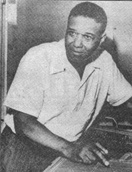Difference between revisions of "Samuel Plato"
| Line 1: | Line 1: | ||
| + | __NOTOC__ | ||
==The Goal== | ==The Goal== | ||
[[image:SamuelPlato.jpg|thumb|Samuel Plato, ca. 1950]]The goal of this online exhibition, ''The Buildings of Samuel Plato, as photographed by David S. Blunk, II'', is to further understanding of the great historical, aesthetic, and moral value placed upon the buildings created by African-American architect Samuel Plato (1882-1957) in Marion, Indiana.. Through the permanent exhibition of fourteen photographs of the ten verified structures designed by Plato, the goal will be accomplished. | [[image:SamuelPlato.jpg|thumb|Samuel Plato, ca. 1950]]The goal of this online exhibition, ''The Buildings of Samuel Plato, as photographed by David S. Blunk, II'', is to further understanding of the great historical, aesthetic, and moral value placed upon the buildings created by African-American architect Samuel Plato (1882-1957) in Marion, Indiana.. Through the permanent exhibition of fourteen photographs of the ten verified structures designed by Plato, the goal will be accomplished. | ||
Revision as of 18:47, 24 March 2007
The Goal
The goal of this online exhibition, The Buildings of Samuel Plato, as photographed by David S. Blunk, II, is to further understanding of the great historical, aesthetic, and moral value placed upon the buildings created by African-American architect Samuel Plato (1882-1957) in Marion, Indiana.. Through the permanent exhibition of fourteen photographs of the ten verified structures designed by Plato, the goal will be accomplished.The buildings designed and contracted by Plato are of great historical value due to their high quality of craftsmanship, authentic use of a multitude of styles, and their ability to defy age. The high craftsmanship of Plato's buildings is a product of the now famous Arts & Crafts movement, in which Plato played a large part. One trademark evident in the buildings Plato designed are the simple yet beautiful windows, along with their placement. All Platonian buildings have finely crafted windows, and most have retained some, if not all of the original glass and casings. Plato learned the art of carpentry from his father, and his talent was evident in the construction of the cabinets, doors, and windows in his buildings. Plato's styles range from bungalow, to Mediterranean, to Greek-revival, yet are all related by the superior craftsmanship and evident carpentry.
The photographs of Plato's buildings are meant to shed new light on the beauty they hold, by introducing unusual angles, subtle print toning, and attention to detail. The light snow, barren trees, and overcast skies all portray a sense of prominence, adding importance sweetened with whimsy to the compositions. The photography is fresh, with a new sense of composition which allows traditional perspective shots along with unusually angled and enlarged details. The subtle brown toning, created by printing a monotone print onto color (C-41) photography paper adds a slight sense of nostalgia to the collection. The attention to detail in craftsmanship, scenery, and background all pull together the unity of the exhibition.
The architecture of Samuel Plato is significant for many different reasons. The most prominent reason could be the success achieved by an African-American Architect in the early Twentieth Century. Samuel Plato turned to designing his own buildings and promoting himself after being turned away from most Caucasian-owned design and contracting companies. During the construction of his buildings, it was an unusual twist of fate that the very contractors which turned Plato down came to him seeking a job. Plato created success from failure, which is was a daunting task for anyone at the time.
The goal of this exhibition is to foster a sense of respect and appreciation for the buildings designed by Samuel Plato. Through exhibiting photography of his buildings, this message will hopefully be illustrated fully.
The Architect
". . . Earl Green, a student of Grant County history, has been trying to get [Samuel] Plato on the Celebrity Audio Walking Tour of Marion for a year or so. He brought the idea to . . . city officials, who agreed it was time to honor Plato.
""First, I think he's very deserving," Green said. "Second, he breaks a stereotype of what people think [African-American] men do. He represents a success story in the field of architecture. A lot of success stories you hear about [African-Americans] stress sports. That isn't always so."
"Plato was born in 1882 in Waugh, Alabama. He moved to the Marion area in 1902, and stayed here until he moved to Louisville, Kentucky in 1921. He died in 1957 at age 75.
". . . In the 19 years [Plato] lived near Marion, he designed and built a number of buildings--but how many can't be verified . . . Incomplete, missing, or non-existent records complicate separating truth from legend.
""Every community has its--shall I say hero? By hero, I mean the person they look up to, the person who contributes to the advancement of the community. And [Plato] was certainly one of them," said Grant County Historian Leslie Neher."
--Article, "City officials want architect, builder added to its tour of history," by Sheri Conover of the Chronicle-Tribune, c.1988
The Photographs
Credits
This article and gallery was created by David S. Blunk, II as a project for the Community History Project at Marion High School. He sincerely wishes to thank William Munn, John Smith, Debi Shepler, The Chronicle-Tribune, Aaron Shepler, and David & Debra Blunk, who have helped him with the project.














